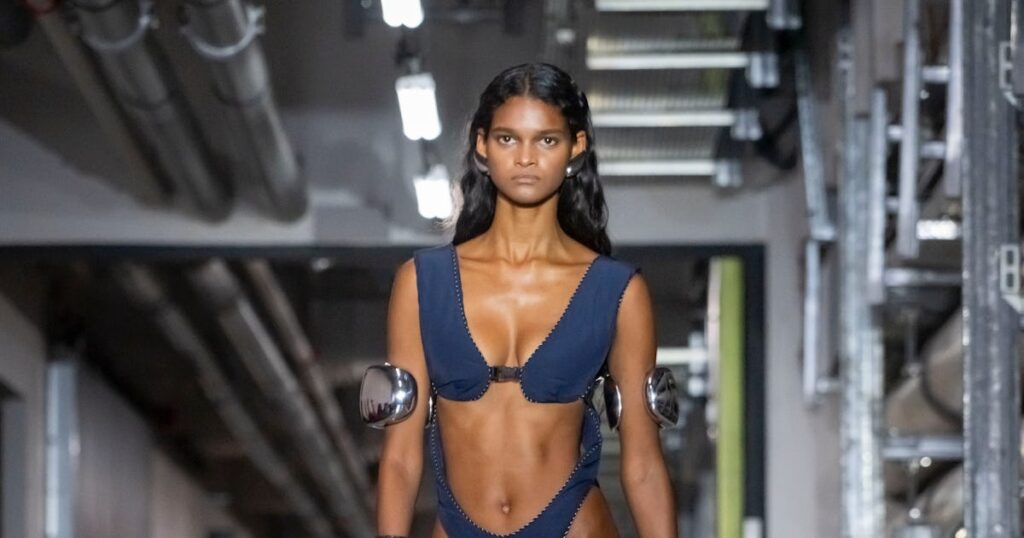Creative director Duran Lantink’s debut for Jean Paul Gaultier tickled brains and provoked the minds of guests in a way that hasn’t been seen this fashion week season. In the industrial basement of the Musée du Quai Branly-Jacques Chirac, complete with bright-yellow tubing and low lights, a slew of bold looks marched through the venue, rejecting the sameness and safeness that big designer switch-ups so often produce.
It was jaw-dropping and totally alien compared to the other spring 2026 runways in Paris. Lantink, known for his master shapeshifting abilities of reconstructing the body through clothes, has become a celeb and fan favorite for his alternate-universe-worthy silhouettes. He is the first designer to take a permanent position at the French house since Gaultier himself retired in 2020, when he showed his 50th anniversary (and final) couture show. True to JPG’s innovative nature, he then kicked off a series of rotating guest designers to create couture shows each season.
Lantink titled the spring 2026 collection “Junior,” inspired by the Junior Gaultier line of 1988-1994. The designer also looked to “Het RoXY Archief, 1988-1999,” a coffee table book by the Dutch photographer Cleo Campert, which follows Amsterdam’s hedonistic club scene of that era. Lantink told the press that he wasn’t going to go into the archives. “First, I want to imagine what’s behind that door and create a fantasy world,” he said. Even so, it was easy to see allusions, both subtle and direct. The result? A melting pot of Lantink’s unique aesthetic combined with Gaultier’s world. Think: wonderful weird and wonky uniforms fit for a new Fifth Element generation, complete with midriff-baring bulbous mini sets, three-dimensional cut-out bodysuits, and sporty utilitarian ankle strap pants. (Jean Paul Gaultier did the costumes for the iconic 1997 film, by the way).
To understand Lantink’s work for Gaultier is to understand the brand’s history itself—being one of the most challenging and outrageously forward-thinking labels of all time. Lantink subverted and reworked codes intrinsic to JPG. The opening look revised the infamous cone bra into a padded, spherical bodysuit straight from Lantink’s lexicon. A white dress mimicked the classic sailor hat with an upturned, stitched hem that mirrored the chapeau’s brim. Skintight, hairy, male-anatomy tops reversed the typical female nude imagery so often seen in fashion ( and was worn by all genders on the runway). One male model wore a padded bustier. During a season of supersexy designs—we’ve seen a literal dress hanging from nipple piercings on a bare-breasted model—Lantink offered up something different.
At every turn, there was a new idea: lumpy bikinis with gold sequins; jackets sporting Lurch-like shoulders; extreme nipped waists; sporty padded pieces in unusual shapes—take your pick. The designer also pulled in cultural references and created a vibe. Guests entered through a bamboo forest and were greeted with a red-lit room full of empty shot glasses, trash, playing cards, and other remnants from the ghosts of parties past. Softly chaotic poetry could be heard murmured throughout the space in a partnership with “Dial-A-Poem,” a telephone hotline founded by New York City artist, poet, and activist John Giorno in 1969.
Lantink’s Jean Paul Gaultier feels inventive and inherently JPG—without being mind-numbingly referential. Even the most wary of critics felt something, even if they didn’t like the collection. Minutes after looks hit the runway, Internet fashion commentators were in a tizzy, calling the designs “disrespectful.” It’s worth remembering that Gaultier himself was once called the enfant terrible of fashion.

